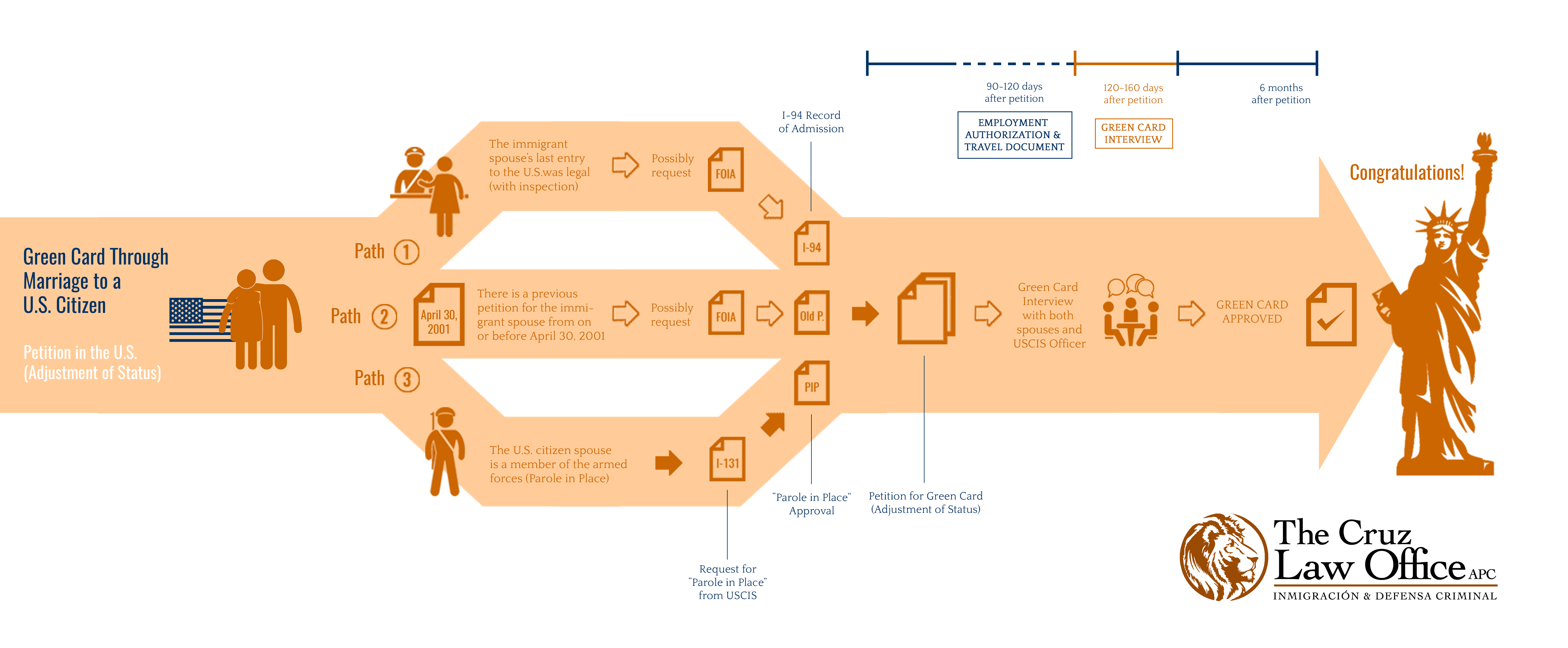How to obtain a Green Card through Marriage to a U.S. Citizen – Adjustment of Status

As an immigration attorney in San Diego, California, I often help clients in obtaining a green card through marriage to a U.S. citizen. My clients are married couples with one U.S. citizen and one foreign-born spouse who live together in the U.S.
In some cases, the foreign-born spouse holds a visa, for example, an H1B work visa or an F1 student visa, but in other cases the foreign-born spouse is undocumented. There are different ways to a green card through marriage, which are explained in more detail below.
Which way is the best for you and your significant other depends on your individual situation. Our lawyers are available to discuss your individual case with you and can answer any further questions you may have – call (619) 717-2233 to book a free consultation.
In general, there are two options to obtain a green card through marriage to a U.S. citizen:
-
Option A – Green Card through Marriage: Adjustment of Status:
Certain immigrant spouses qualify to petition for a green card from within the U.S. and can thus adjust their status to “legal permanent resident” without leaving the U.S. To be eligible for this “adjustment of status” from within the U.S., the immigrant spouse has to fulfill certain requirements which are explained in this article. -
Option B – Green Card through Marriage: Consular Processing:
If the immigrant spouse is not eligible to petition for a green card from within the U.S., he or she has to travel abroad to obtain an immigrant visa, including an interview at a U.S. consulate. This article explains this option process in more detail.
If you think you meet the requirements to petition for a green card from within the U.S. and you would like to learn more about the process of petitioning for a green card based on marriage to a U.S. citizen, this article explains every step of the process and which documents you will need to begin your journey.
An immigrant spouse is eligible to petition for a green card from within the U.S., in other words, to “adjust status” if he or she qualifies to take one of these three different “paths”:
- Path I – The immigrant spouse’s last entry into the U.S. was ‘legal’
- Path II – Someone previously petitioned for the immigrant spouse on or before April 30, 2001
- Path III – The U.S. citizen spouse is an active member or a veteran of the armed forces (military parole and place)
Path I – The Immigrant Spouse’s Last Entry into the U.S. was ‘Legal’
The first and easiest way to petition for a green card from within the U.S. requires that the immigrant spouse’s last entry into the U.S. was a legal entry. This means that he or she was lawfully admitted to the U.S. (e.g. on a tourist visa, a student visa, etc.) and inspected by U.S. immigration officers. Often times, foreign nationals come to live in the U.S. by overstaying on a tourist visa (B1/B2 Visa). Nevertheless, their legal entry into the U.S. via an airport, a seaport, or a border port of entry (like the San Ysidro Port of Entry) is documented.
How can I prove the last entry into the U.S. was legal?
To prove that the immigrant spouse’s last entry to the U.S. was legal, you will have to submit evidence. This evidence may include an I-94 admission record, a stamped passport, a border crossing card, or similar.
If the immigrant spouse last legal entry to the U.S. was within the past five years, you can easily obtain the I-94 admission record through www.cbp.gov/i94.
How can I prove my last entry into the U.S. was legal if I don’t have any record?
If an I-94 is not available online for the immigrant spouse because his or her last legal entry dates back further than the past five years, you can file a Freedom of Information Act (FOIA) request. A FOIA request allows a member of the public to access their own records held by any government agency. Our immigration lawyers can help you determine if you need to file a FOIA request to obtain lost or misplaced entry records and assist you in the process.
Path II – A Petition was Previously Filed on or before April 30, 2001,
on Behalf of the Immigrant Spouse
If the last entry into the U.S. was not legal, the immigrant spouse may still be eligible topetition for a green card from within the U.S. if they were the beneficiaries of an application submitted on or before April 30, 2001, for example, a labor certification (I-140) or an immigrant visa petition (I-130).
The immigrant spouse may have been petitioned by a business they worked for or by another family member like a brother or sister. If their application petition was filed on or before April 30, 2001, they may qualify for adjustment of status from within the U.S. under the Immigration and Nationality Act (INA) Section 245 (i) – even if their last entry was not legal. Under these circumstances, they may have the opportunity to obtain a green card in the U.S. if they pay a $1,000 penalty.
How do I prove a petition was filed on or before April 30, 2001?
The evidence USCIS requires in these cases is the original receipt of the petition submitted on behalf of the immigrant spouse. If you do not have the original petition in your personal documents anymore you can obtain it by filing a request under the Freedom of Information Act (FOIA). The FOIA was enacted to allow the public to access the own records held by any government agency. Our immigration law office can help you file your FOIA request.
Why are previous petitions still relevant under INA 245 (i)?
Wait times of several years for the approval of an immigrant visa petition are not uncommon in the U.S. immigration system because it is a preferred category system. This means that the government created categories for the different kinds of relationship between an immigrant relative and the U.S. citizen or legal permanent resident petitioning. Some categories of immediate relatives such as spouses or unmarried children under the age of 21 are considered a priority and petitions will be approved immediately or with a very short wait time.
For other categories of non-immediate family members, such as brothers and sisters, the wait time may be much longer. Therefore, it is possible that a petition on behalf of the immigrant spouse was submitted on or before April 30, 2001, but USCIS has not approved it yet.
Path III – The U.S. Citizen spouse is an Active Member or a Veteran of the Armed Forces (Parole in Place)
Even if the immigrant spouse does not qualify for petitioning from the U.S. via the first two paths, there is another option for your family if the U.S. citizen spouse is an active member or a veteran of the armed forces. In this case, the immigrant spouse may be eligible for “parole in place (PIP)”. Through PIP, USCIS can legally “parole” an immigrant spouse into the U.S. and thus make their last entry a legal entry.
How can I know if USCIS will grant my non-citizen spouse Parole in Place?
The decision whether to grant or not to grant immigrant spouses parole in place is at the discretion of USCIS. Even though it is not possible to know for certain whether USCIS will grant a PIP request, your chances are better if your parents meet the following criteria: Good moral character, no criminal history, no extensive immigration violations.
Legal Disclaimer: Nothing in this website should be taken as legal advice for an individual case or situation. The information is intended to be general and should not be relied upon for any specific situation.
For more information, contact The Cruz Law Office.



